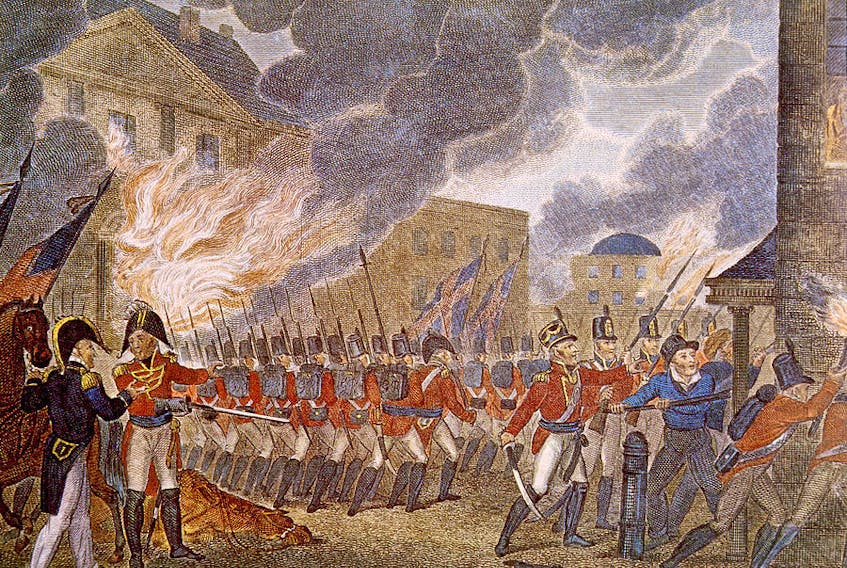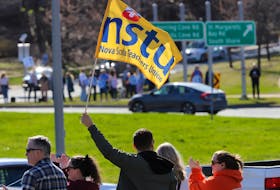Time and distance are nothing in this 24-7, everyone-and-everything-is-connected age. So, like you, I watched with horror and disbelief in real time as the inevitable culmination of four years of Donald Trump unfolded Wednesday in Washington.
The last time the United States capital was overrun, leaving its legislators fleeing for their lives, and its hallways to be looted by enemies, you would have had to be there to see the chaos with your own eyes rather than on a cellphone or laptop screen.
Like Maj.-Gen. Robert Ross, whose rum-soaked body lies in the Old Burying Ground down on Barrington Street in Halifax.
Due to COVID-19 you can’t get into the cemetery right now to see his grave. But there are some explanatory panels on the gates outside that tell story of the Irish-born soldier with the regal nose and hint of a double chin who served with distinction during the Napoleonic Wars, only to be given command of the British Army on the eastern coast of the United States in the War of 1812.

Under Ross’s command, the British troops routed the United States forces at Blandesburg, Virginia, 13.8 km northeast of Washington on Aug. 24, 1814. The defeat was so lop-sided that historians have labeled it the “the greatest disgrace ever dealt to American arms.”
It just so happens that a surgeon from Cornwallis, Nova Scotia, was right there watching history unfold in Washington in the same way that we, via social media, observed Tuesday’s insurrection.
John Fox, the Nova Scotia Archives tells us, was educated in Pictou County, and, at 17, went to Ireland to study medicine.
He would go on to have an enviable career as a physician in London, and later back in Nova Scotia where, according to a biographical sketch prepared by the archivist Phyllis Blakeley, Fox was “long remembered for his surgical skill and his kindness to widowed and orphans.”
What matters to us today is that in 1813, at the age of 19, Fox was appointed assistant surgeon in the British Navy, soon after ending up aboard HMS Majestic. That after being pressed into blockade service along the eastern coast of the United States, and being stationed briefly in Bermuda and at Halifax, the Majestic became part of the squadron of Admiral Sir Alexander Cochran. And that from there, they sailed to join Ross and his troops, as they prepared to attack Washington.
Fortunately, for history’s sake, Fox wrote a letter to his father Cornelius on Dec. 5, 1814, in which he waxed on about the beauty of Chesapeake Bay.
This, though, was no travelogue.

“Having about 6000 of Lord Wellingtons Troops & our Naval Force being adequate to anything that might be required,” he wrote, “we made an attack upon the City of Washington on the night of the 24th.”
The American army, he went on to say, were drawn up in “Admirable Order.” but after the first round “were put in great Confusion & disorder” and retreated “with great Precipitation.”
According to Fox, no more than 200 British were dead or injured, while “that of the Enemy supposed to be near 10 times that Number.”
The retreat left the British troops “in quiet and peace possession of their Capital,” since Washington had already been evacuated by James Madison’s government.
From that point, Fox wrote, “they burned to the Ground beginning with the house of Congress War & Intelligence Office Mr. Maddisons house the Dock Yard &c until a General Conflagration ensued.”
See a digital copy of Fox's letter, read its full transcript and learn more at the Nova Scotia Archives online
Fox’s eyewitness account of the torching of Washington — in part as revenge for the American sacking of York, present day Toronto — doesn't end there.
“Some of our Officers had recourse to Mr. Madison's wardrobe where they Shifted their linnen,” he wrote. At six the next morning they proceeded to Nottingham, about 32 kilometres from Washington.

In flames they left “A large frigate on the stocks & destroying about 60 pieces.”
The occupation didn’t last long. A heavy thunderstorm extinguished the fires, and pushed the British troops back to their ships. Their total occupation lasted only 26 hours.
We don’t know exactly what happened to Fox once he left Washington, other than that eventually he was discharged from the navy. He spent a year doctoring in London, then returned to Nova Scotia where, in the years that followed, he practised his profession in Argyle, Barrington, Horton (now Wolfville), Shelburne, New Glasgow, Guysborough, Halifax, Windsor, and Bridgetown, before returning to Barrington District.
Ross’s fate, though, is the stuff of legend. After Washington, he headed for Baltimore. There, he was shot by an American sniper.
Ross died on the way back to his fleet. His remains were preserved in a hogshead of Jamaican rum. Then, for some reason, they were shipped to Halifax, where they were laid in the Old Burying Ground and where they still lie today, connecting us through time and space to the unsettling events in Washington.









